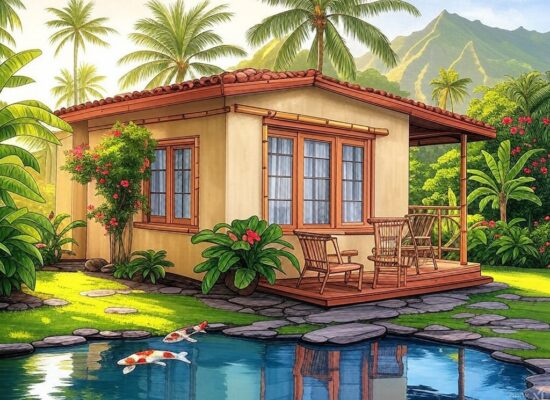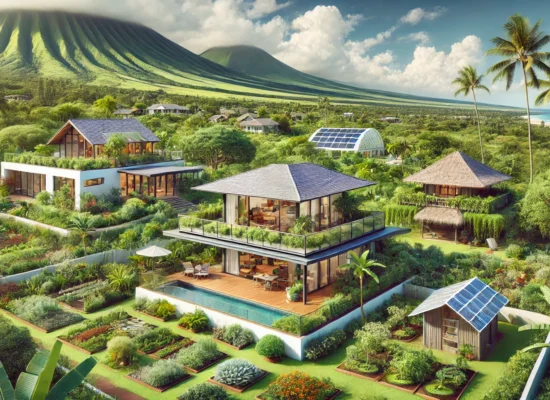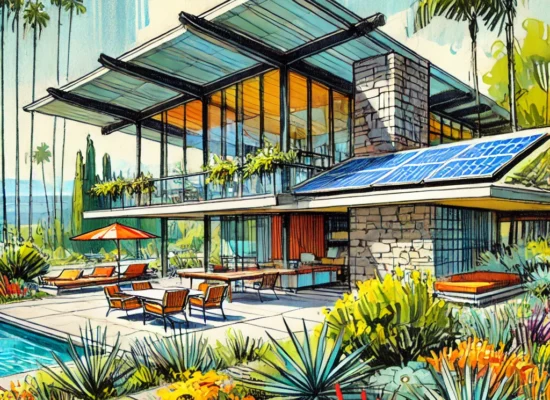Hawaii Architecture: A Blend of Traditional and Contemporary Styles
If you’re looking to build a custom home in Hawaii, it’s important to understand the different architectural styles that have influenced home design on the islands. From the traditional Hawaiian Mission style to the sleek Italian-inspired Hawaiian Renaissance architecture, each style has its unique features that can complement your lifestyle and the natural surroundings. In this blog post, we’ll explore some of the most popular architectural styles in Hawaii and what makes them distinctive. So, let’s dive in!
Hawaiian Architecture Prior to Western Influences
Prior to the arrival of western missionaries, Hawaiian architecture was deeply rooted in the island’s natural resources and cultural heritage. The indigenous people of Hawaii utilized local materials like lava rock, coral blocks, and palm fronds to construct their homes, temples, and communal spaces. The traditional Hawaiian style of architecture featured open-air designs, thatched roofs, and a strong connection to the natural environment. These structures were often decorated with intricate carvings and adorned with natural elements like seashells and feathers. The architecture of pre-missionary Hawaii reflected a reverence for the land, sea, and sky, and served as a physical manifestation of the spiritual beliefs and values of its people.
Exploring the Diverse Architectural Styles of Hawaii
Hawaii is not just a land of pristine beaches, lush vegetation, and warm sunshine. It is also a melting pot of different cultures and traditions that have left their mark on the architecture of the islands. From the simple, modest style of the Hawaiian Mission Architecture to the sleek structure of Italian buildings in Hawaiian Renaissance Architecture, there are many architectural styles to consider when building a custom home in Hawaii. In this blog post, we will take a closer look at the rich and diverse architectural styles of Hawaii and how they continue to influence contemporary designs today.
Hawaii Mission Architecture
The early architecture of Hawaii was heavily influenced by the arrival of American Protestant missionaries from New England in the early 1800s. These missionaries built homes and churches with high-pitched roofs and clapboards, which were more aligned with their religious values. This style of architecture, known as Hawaiian Mission Architecture, was a blend of traditional American architecture with the resources available in Hawaii, such as coral blocks. It is still seen in many historical buildings today, such as Kawaiaha’o Church, the oldest Christian church in Hawaii.
Hawaiian Renaissance Architecture
In the late 1800s, the Hawaiian Renaissance brought about a resurgence of Hawaiian culture and arts. This cultural movement also had an impact on architecture, with the introduction of Italian-style buildings such as Ali’iolani Hale, which was designed by Australian architect Thomas Rowe to be a palace but was repurposed into a government building before its completion in 1874. The stately, ornate style of Hawaiian Renaissance Architecture is still visible today in buildings like Iolani Palace, the former royal residence of the Kingdom of Hawaii.
Hawaii Romanesque Architecture
Hawaiian Romanesque Architecture is reminiscent of Roman architecture, with the use of large, dark basalt boulders, rounded arches, and cruciform piers. This style can be seen in buildings such as the Hawaii State Capitol, which was completed in 1969 and features a rotunda, reflecting pool, and columns that evoke a sense of grandeur.
Hawaiian Art Deco/Beaux-Arts
In the 1920s and 1930s, Hawaii experienced a period of neoclassicism, with the popularization of Art Deco and Beaux-Arts styles. These styles combine ancient Greek and Roman architecture to create something modern and unique. The Hawaii Theatre, which opened in 1922, is an example of Art Deco architecture that is still visible today. It features bold geometric shapes, decorative motifs, and a colorful facade.
Hawaiian International/Bauhaus Architecture
The International/Bauhaus architectural style was introduced to Hawaii in the mid-20th century and is easily recognizable by its plain style with clean lines, open layouts, and pervasive use of black and gray concrete. This style was typically used for office buildings in Honolulu, but it also makes an appearance in the Hawaii State Capitol Building, which was designed by architect John Carl Warnecke and completed in 1969.
Hawaii Plantation Architecture
Hawaii Plantation Architecture became popular in the 1970s and 1980s, inspired by the large homes on sugarcane plantations. This style is characterized by wide-hipped roofs, deep eaves, large porticos, and vertical plank siding. It reflects the rural lifestyle of Hawaii’s agricultural past and can be seen in homes and buildings throughout the islands.
Contemporary Hawaii Architecture
Today, contemporary Hawaiian architecture continues to evolve, combining elements of traditional styles with modern techniques and materials. The Dickey roof, popularized by Charles William Dickey in the 1920s, is still popular in contemporary designs. It features wide, shallow-pitched eaves combined with a steep upper roof. This design is not only aesthetically pleasing but also highly functional, making it well-suited to withstand the wind-driven rains typical of Hawaiian tropical storms. Contemporary Hawaiian homes often use natural materials such as lava stone and local woods, which help to blend the home with its surroundings. Open floor plans and large windows are also common features, allowing homeowners to take full advantage of the island’s breathtaking views and temperate climate. Many contemporary homes also incorporate sustainable and eco-friendly features, such as solar panels and rainwater catchment systems, reflecting Hawaii’s commitment to environmental conservation.
 Copyright secured by Digiprove
Copyright secured by Digiprove 



